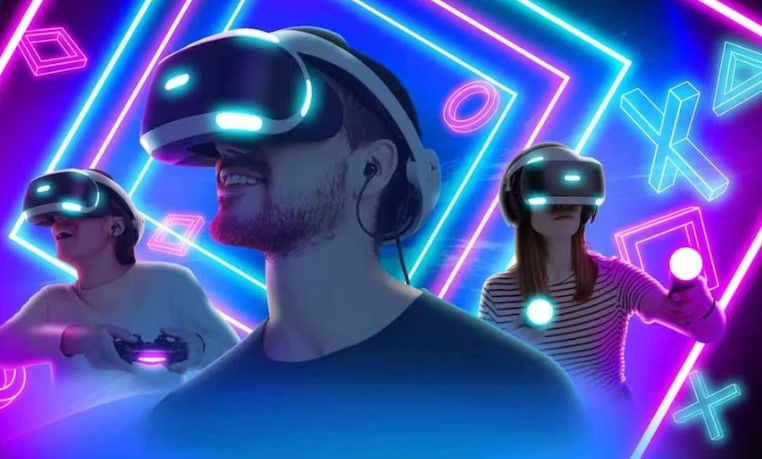Video games have been around in one form or another since the early 1970s. Since that time they have evolved in many ways and the incredibly immersive experiences that are available to gamers to do would be almost unimaginable looking back at some of the earliest games on the market. Even without VR and other immersive tech, the accessibility to playing games online in a smooth and seamless way is off the scale in comparison to decades ago.
Today, we’ll be looking at how technology is playing a key role in changing the gameplay experience as well as creating a level of immersion not previously seen. Let’s start by taking a closer look at one of the biggest changes in gaming technology in recent years – virtual reality.

VR and how it’s changing the game
VR is not a new concept in the gaming world. In fact, gaming VR headsets were being produced as early as 1993, when Sega released the Sega VR headset. Its biggest competitor at the time, Nintendo also released their own VR console in 1995 – the Virtual Boy. However neither of these devices were a commercial success, mostly due to the limited technology available at the time and lack of games.
For a while, it looked like VR was doomed to be a relic of the past but in the early 2010s, interest and development in VR started to pick up again. Companies like Google, Sony, Microsoft and Facebook all started developing their own VR headsets and today, there are a number of options available for PC and console gamers as well as mobile gamers.
Although VR gaming hasn’t quite broken through to the mainstream to the extent that something like mobile gaming has, it seems inevitable that it will only become more popular as VR headsets become more compact and lightweight and their price comes down.
There are already several major franchises that are available as VR experiences, including Resident Evil, Half Life, Horizon and Minecraft. Major developers will no doubt continue to explore the potential of VR and continue creating immersive gaming experiences for years to come.
AR technology and its role in the future of gaming
AR might not have received the same amount of attention as VR has in the past decade or so but that is quickly changing. Apple recently announced its Vision Pro headset, which although isn’t strictly a gaming device, does represent a major leap forward in terms of getting AR technology out to a mainstream audience.
Gaming companies have dabbled in AR technology for quite a while. One of the first experiences that many gamers had with AR was when Pokémon Go was released in 2016. It used AR technology to overlay characters, items and menus from the game onto real world settings.
Pokémon Go didn’t quite propel AR development in the way many predicted it would at the time and it’s been fairly quiet over the last past 7-8 years, with more focus being put on VR headsets. However, Apple’s new Vision Pro is a sign that major companies are not ready to give up on the technology and it’s likely that in the future that games and headsets will combine VR and AR technology to create the most immersive experiences possible.
How AI will continue to be integrated in the gaming experience
Artificial Intelligence (AI) is nothing new in the gaming world. In fact it’s been part of gaming since the very beginning. Playing against a computer, requires the computer to be able to think for itself, at least to some degree, in order for there to be a challenge for the player.
However, AI has changed a lot in the past few years and the level of technology now available is rapidly advancing all the time. While it’s traditionally been used for non-playable characters and opponents in games, AI in the future of gaming will play a much bigger role. Things like concept art, script writing and scenarios have always been done by humans
AI can also be used for more practical things like bug testing and optimization. This increased use of AI in all facets of game development will only result in more immersive experiences for gamers and likely lead to new innovations not yet thought of.
Continuing graphical leaps
When talking about immersion, it’s easy to focus solely on things like VR and AR i.e. things that change how you physically perceive games. However, another huge aspect of the increasing immersion of games is the ever-increasing sophistication of graphics.
Things like ray tracing and advanced lighting effects have helped make many modern games look incredibly realistic and this is just the start. The recent Unrecord gameplay demo left many people wondering if it was video footage rather than an actual functioning game.
Conclusion
The future of gaming is exciting. As current technologies evolve and new technologies emerge, it’s likely that games in the future will be even more immersive than we could ever imagine.
I'm a published author and proud US Army veteran who happens to be a gamer, so I decided to combine the two and love every minute of it! Feel free to contact me with any questions or comments and I'll be sure to get back to you.





More Stories
Center Cam V2.0 Webcam Review
Black Friday Peripheral Deals to Lookout For
The Digital Revolution: How Technology Has Transformed Online Gaming